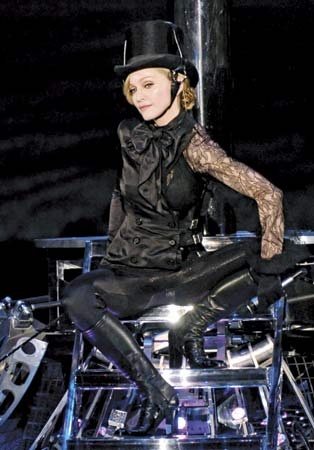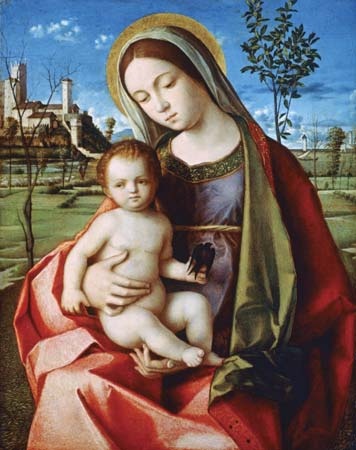Madonna
American singer and actress
Introduction
original name Madonna Louise Ciccone
born August 16, 1958, Bay City, Michigan, U.S.
 American singer, songwriter, actress, and entrepreneur whose immense popularity in the 1980s and '90s allowed her to achieve levels of power and control unprecedented for a woman in the entertainment industry.
American singer, songwriter, actress, and entrepreneur whose immense popularity in the 1980s and '90s allowed her to achieve levels of power and control unprecedented for a woman in the entertainment industry.Born into a large Italian-American family, Madonna studied dance at the University of Michigan and with the Alvin Ailey (Ailey, Alvin, Jr.) American Dance Theater in New York City in the late 1970s before relocating briefly to Paris as a member of Patrick Hernandez's disco revue. Returning to New York City, she performed with a number of rock groups before signing with Sire Records. Her first hit, “Holiday,” in 1983, provided the blueprint for her later material—an upbeat dance-club sound with sharp production and an immediate appeal. Madonna's melodic pop incorporated catchy choruses and her lyrics concerned love, sex, and relationships—ranging from the breezy innocence of “True Blue” (1986) to the erotic fantasies of “Justify My Love” (1990) to the spirituality of later songs such as “Ray of Light” (1998). Criticized by some as being limited in range, her sweet, girlish voice nonetheless was well-suited to pop music.
Madonna was the first female artist to exploit fully the potential of the music video. She collaborated with top designers (Jean-Paul Gaultier), photographers (Steven Meisel and Herb Ritts), and directors (Mary Lambert and David Fincher), drawing inspiration from underground club culture or the avant-garde to create distinctive sexual and satirical images—from the knowing ingenue of “Like a Virgin” (1984) to the controversial red-dressed “sinner” who kisses a black saint in “Like a Prayer” (1989). By 1991 she had scored 21 Top Ten hits in the United States and sold some 70 million albums internationally, generating $1.2 billion in sales. Committed to controlling her image and career herself, Madonna became the head of Maverick, a subsidiary of Time-Warner created by the entertainment giant as part of a $60 million deal with the performer. Her success signaled a clear message of financial control to other women in the industry, but in terms of image she was a more ambivalent role model.
In 1992 Madonna took her role as a sexual siren to its full extent when she published Sex, a soft-core pornographic coffee-table book featuring her in a variety of “erotic” poses. She was criticized for being exploitative and overcalculating, and writer Norman Mailer (Mailer, Norman) said she had become “secretary to herself.” Soon afterward Madonna temporarily withdrew from pop music to concentrate on a film career that had begun with a strong performance in Desperately Seeking Susan (1985), faltered with the flimsy Shanghai Surprise (1986) and Dick Tracy (1990), and recovered with Truth or Dare (1991, also known as In Bed with Madonna), a documentary of one of her tours. She scored massive success in 1996 with the starring role in the film musical Evita. That year she also gave birth to a daughter.
 In 1998 Madonna released her first album of new material in four years, Ray of Light. A fusion of techno music and self-conscious lyrics, it was a commercial and critical success, earning the singer her first musical Grammy Awards (her previous win had been for a video). Her experimentation in electronica continued with Music (2000). In 2005 she returned to her roots with Confessions on a Dance Floor. Despite a marriage in the 1980s to actor Sean Penn (Penn, Sean) and another to English director Guy Ritchie (married 2000; divorced 2008), with whom she had two sons, Madonna remained resolutely independent. That independent streak, however, did not prevent her from enlisting the biggest names in music to assist on specific projects. This fact was clear on Hard Candy (2008), a hip-hop infused effort with writing and vocal and production work by Justin Timberlake (Timberlake, Justin), Timbaland, and Pharrell Williams of the hit-making duo The Neptunes. In 2008 she was inducted into the Rock and Roll Hall of Fame.
In 1998 Madonna released her first album of new material in four years, Ray of Light. A fusion of techno music and self-conscious lyrics, it was a commercial and critical success, earning the singer her first musical Grammy Awards (her previous win had been for a video). Her experimentation in electronica continued with Music (2000). In 2005 she returned to her roots with Confessions on a Dance Floor. Despite a marriage in the 1980s to actor Sean Penn (Penn, Sean) and another to English director Guy Ritchie (married 2000; divorced 2008), with whom she had two sons, Madonna remained resolutely independent. That independent streak, however, did not prevent her from enlisting the biggest names in music to assist on specific projects. This fact was clear on Hard Candy (2008), a hip-hop infused effort with writing and vocal and production work by Justin Timberlake (Timberlake, Justin), Timbaland, and Pharrell Williams of the hit-making duo The Neptunes. In 2008 she was inducted into the Rock and Roll Hall of Fame.Representative Works
● Like a Virgin (1984)
● True Blue (1986)
● Like a Prayer (1989)
● Erotica (1992)
● Bedtime Stories (1994)
● Ray of Light (1998)
● Music (2000)
Additional Reading
Christopher Andersen, Madonna, Unauthorized (1991); and Mark Bego, Madonna: Blonde Ambition (1992), are biographies.
religious art
 in Christian (Christianity) art, depiction of the Virgin Mary; the term is usually restricted to those representations that are devotional rather than narrative and that show her in a nonhistorical context and emphasize later doctrinal or sentimental significance. The Madonna is accompanied most often by the infant Christ, but there are several important types that show her alone.
in Christian (Christianity) art, depiction of the Virgin Mary; the term is usually restricted to those representations that are devotional rather than narrative and that show her in a nonhistorical context and emphasize later doctrinal or sentimental significance. The Madonna is accompanied most often by the infant Christ, but there are several important types that show her alone.The theme of the Madonna and Child was rare in the first centuries of early Christian art (c. 3rd–6th century). In 431, however, the establishment of Mary's title of Theotokos (“Mother of God”) definitively affirmed the full deity of Christ; thereafter, to emphasize this concept, an enthroned Madonna and Child were given a prominent place in monumental church decoration.
 Byzantine art developed a great number of Madonna types. All are illustrated on icons, and one or another type was usually pictured prominently on the eastern wall of Byzantine churches below the image of Christ; the location dramatized her role as mediator between Christ and the congregation. The major types of the Madonna in Byzantine art are the nikopoia (“bringer of victory”), an extremely regal image of the Madonna and Child enthroned; the hodēgētria (“she who points the way”), showing a standing Virgin holding the Child on her left arm (see photograph-->
Byzantine art developed a great number of Madonna types. All are illustrated on icons, and one or another type was usually pictured prominently on the eastern wall of Byzantine churches below the image of Christ; the location dramatized her role as mediator between Christ and the congregation. The major types of the Madonna in Byzantine art are the nikopoia (“bringer of victory”), an extremely regal image of the Madonna and Child enthroned; the hodēgētria (“she who points the way”), showing a standing Virgin holding the Child on her left arm (see photograph--> ); and the blacherniotissa (from the Church of the Blachernes, which contains the icon that is its prototype), which emphasizes her role as intercessor, showing her alone in an orant, or prayer posture, with the Child pictured in a medallion on her breast. The Virgin also figured prominently as an intercessor in the group of the Deësis, where she and St. John the Baptist appear as intercessors on either side of Christ. In addition to these rather ceremonial types, the Virgin also appears in the less-frequently represented, more intimate types of the galaktotrophousa, in which she nurses the Child, and the glykophilousa, in which the Child caresses her cheek while she seems sadly to contemplate his coming Passion.
); and the blacherniotissa (from the Church of the Blachernes, which contains the icon that is its prototype), which emphasizes her role as intercessor, showing her alone in an orant, or prayer posture, with the Child pictured in a medallion on her breast. The Virgin also figured prominently as an intercessor in the group of the Deësis, where she and St. John the Baptist appear as intercessors on either side of Christ. In addition to these rather ceremonial types, the Virgin also appears in the less-frequently represented, more intimate types of the galaktotrophousa, in which she nurses the Child, and the glykophilousa, in which the Child caresses her cheek while she seems sadly to contemplate his coming Passion.In the West, particularly with the spread of devotional images at the end of the European Middle Ages, the theme of the Madonna was developed into a number of additional types, in general less rigidly defined than those of the East but often modeled on Byzantine types. As a rule, Western types of the Madonna sought to inspire piety through the beauty and tenderness rather than the theological significance of the subject.
One of the earliest strictly Western Madonna types is a standing Gothic Madonna, a lyrical image of the smiling Virgin and playful Child, which was modeled on the Byzantine hodēgētria and found its finest expression in sculpture in the 13th century. When, in the 14th century, painted altarpieces became common, the Madonna enthroned, derived from the nikopoia, was a favourite subject for a time; it was particularly popular in Italy as the maestà, a very formal representation of the enthroned Madonna and Child surrounded by angels and sometimes saints.
More personal depictions of the figures began to emerge in the 14th century. By far the most popular type in the West throughout the Renaissance and into the Baroque period was that derived from the glykophilousa. Though this type has many variants, it usually depicts a Virgin of grave expression, turning her gaze away from the playful Child.
Other, less-intimate Madonna types are the Italian sacra conversazione, depicting a formal grouping of saints around the Madonna and Child, and the northern themes of the Madonna of the rose garden, which symbolizes Mary's virginity, and the seven sorrows of Mary, showing seven swords piercing the Virgin's heart.
Three major Madonna types showing the Virgin alone have theological significance. As the Madonna of mercy, which flourished in the 15th century, the Virgin spreads her mantle protectively over a group of the faithful. The immacolata, which in the 17th century emphasized her Immaculate Conception, or perpetual freedom from original sin, shows her as a young girl descending from the heavens, supported by a crescent moon and crowned by stars. The Madonna of the rosary, which until the 16th century also omitted the Child, shows the Virgin giving the rosary to St. Dominic, founder of the order that spread its use.
As did most religious art, the theme of the Madonna suffered a decline in the major arts after the 17th century. Representations of the Madonna and Child, however, continued to be important in popular art into the 20th century, most following 16th- and 17th-century models; the few examples of the subject produced by “fine” artists are too individual to be classified into types. See also Pietà. (Pietà)
- Kingman
- Kingman Brewster, Jr.
- Kingman, Jr. Brewster
- Kingman Reef
- King, Martin Luther, Jr.
- King Oliver
- Kingo, Thomas
- King Philip's War
- King Ranch
- King, Rufus
- Kings and queens regnant of Spain
- Kings, books of
- Kings Canyon National Park
- Kings County
- king's evil
- Kingsford Smith, Sir Charles Edward
- Kingsley, Charles
- Kingsley Davis
- Kingsley, Henry
- Kingsley, Mary Henrietta
- Kingsley, Sir Ben
- King's Lynn
- King's Lynn and West Norfolk
- King's Men
- Kings Mountain, Battle of